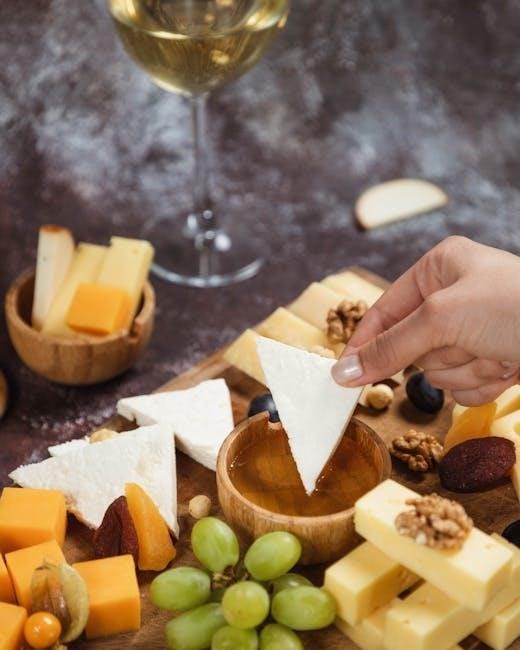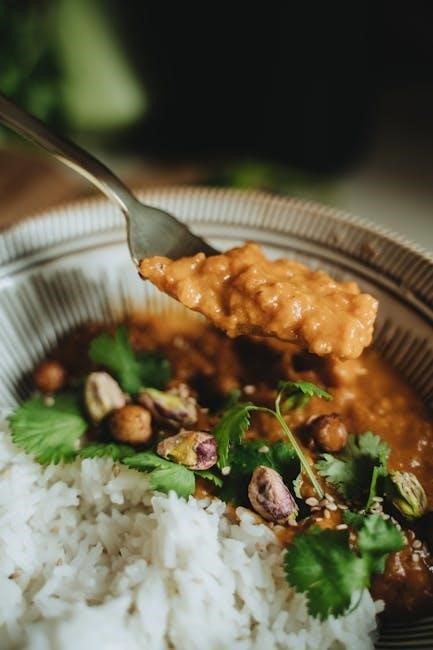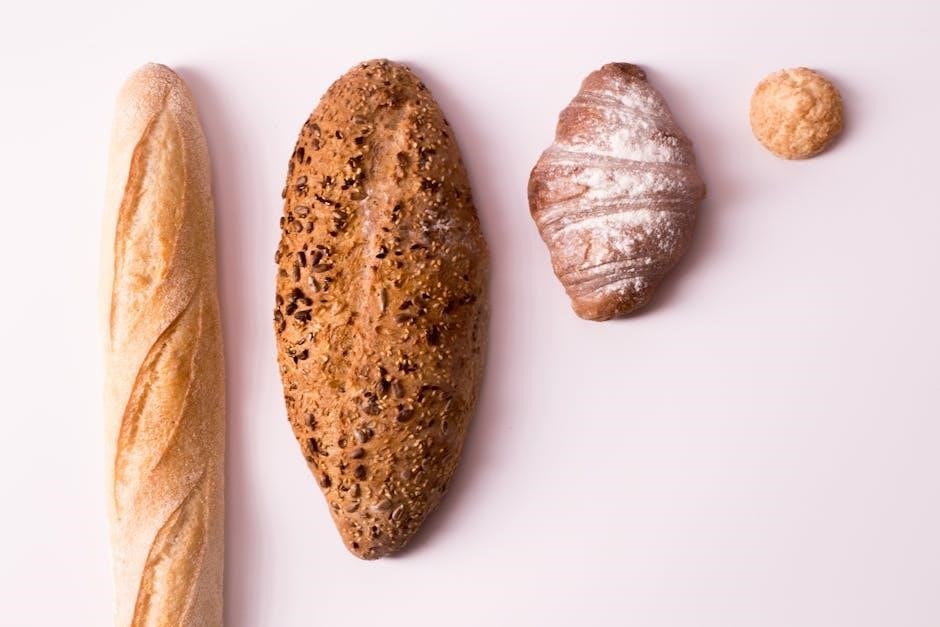Gluten and Dairy-Free Food List PDF: A Comprehensive Guide
Embark on a journey to discover the world of gluten and dairy-free eating․ This comprehensive guide provides an ultimate food list‚ helping you navigate dietary restrictions․ A downloadable PDF ensures easy access to information‚ empowering informed food choices for a healthier lifestyle today!
Embarking on a gluten and dairy-free diet can seem daunting‚ but it opens a world of culinary possibilities and improved well-being․ This dietary approach eliminates gluten‚ a protein found in wheat‚ barley‚ and rye‚ and dairy products‚ which contain lactose‚ a sugar naturally present in milk․
The rise in popularity of gluten and dairy-free eating stems from increased awareness of food sensitivities‚ allergies‚ and autoimmune conditions like celiac disease․ However‚ many individuals without diagnosed conditions also report feeling better by reducing or eliminating these components from their diet․
This guide provides a comprehensive resource to navigate this dietary landscape․ It offers a clear understanding of what to avoid‚ what to embrace‚ and how to create delicious and satisfying meals․ Whether you’re newly diagnosed with an intolerance or simply curious about the potential benefits‚ this introduction will equip you with the knowledge to make informed choices and thrive on a gluten and dairy-free path․ Embrace a journey of flavorful alternatives and renewed vitality!

Understanding Gluten and Dairy Intolerance
Gluten and dairy intolerances manifest differently‚ impacting individuals uniquely․ Gluten intolerance‚ often associated with celiac disease or non-celiac gluten sensitivity‚ triggers adverse reactions upon gluten consumption․ Celiac disease‚ an autoimmune disorder‚ damages the small intestine‚ hindering nutrient absorption․ Non-celiac gluten sensitivity presents similar symptoms but lacks the intestinal damage․
Dairy intolerance‚ primarily lactose intolerance‚ arises from insufficient lactase‚ the enzyme responsible for breaking down lactose․ Undigested lactose ferments in the gut‚ causing discomfort․
Symptoms of gluten intolerance include bloating‚ abdominal pain‚ diarrhea‚ fatigue‚ and skin rashes․ Dairy intolerance symptoms often involve gas‚ bloating‚ diarrhea‚ and nausea․ Severity varies depending on the individual and the amount consumed․
Diagnosis involves medical evaluation‚ including blood tests‚ endoscopy for celiac disease‚ and lactose tolerance tests for dairy intolerance․ Managing these intolerances requires dietary modifications‚ primarily eliminating gluten and dairy products․ Understanding these conditions empowers informed choices‚ promoting well-being and minimizing discomfort․ This knowledge forms the foundation for navigating a gluten and dairy-free lifestyle effectively․
Foods to Avoid on a Gluten and Dairy-Free Diet
Navigating a gluten and dairy-free diet requires careful attention to food choices․ Gluten‚ a protein found in wheat‚ rye‚ and barley‚ is prevalent in many common foods․ Therefore‚ avoid bread‚ pasta‚ cereals‚ cakes‚ pastries‚ and many processed foods containing these grains․ Read labels diligently‚ as gluten can hide in unexpected places like sauces‚ dressings‚ and even some medications․
Dairy‚ encompassing milk and its derivatives‚ is equally pervasive․ Exclude milk‚ cheese‚ yogurt‚ butter‚ cream‚ and ice cream․ Be mindful of hidden dairy in processed foods‚ such as whey‚ casein‚ and lactose․ These ingredients are often used as additives․
Specific foods to avoid include traditional pizzas‚ sandwiches‚ and baked goods․ Many soups and sauces use wheat flour as a thickener‚ so scrutinize ingredient lists․ When dining out‚ inform your server about your dietary restrictions to ensure your meal is prepared safely․
Cross-contamination is a significant concern․ Ensure that your cooking surfaces and utensils are clean and free from gluten and dairy residue․ Opt for dedicated gluten and dairy-free products whenever possible․ By diligently avoiding these foods‚ you can effectively manage your gluten and dairy intolerances․
Naturally Gluten and Dairy-Free Foods: A Detailed List
Discover a wealth of naturally gluten and dairy-free foods that form the foundation of a satisfying and nutritious diet․ Embrace fresh fruits and vegetables‚ packed with vitamins‚ minerals‚ and antioxidants․ Opt for a colorful array‚ from leafy greens to vibrant berries‚ to maximize your nutrient intake․ These are naturally free from gluten and dairy․
Lean proteins like chicken‚ fish‚ beef‚ and pork are excellent choices․ Ensure they are prepared without gluten or dairy-based sauces or marinades․ Legumes‚ including beans‚ lentils‚ and peas‚ offer a plant-based protein source‚ rich in fiber and essential nutrients․ Nuts and seeds provide healthy fats‚ protein‚ and essential minerals․ Enjoy almonds‚ walnuts‚ chia seeds‚ and flax seeds in moderation․
Explore gluten-free grains such as rice‚ quinoa‚ corn‚ and oats (ensure they are certified gluten-free to avoid cross-contamination)․ These grains can be used in a variety of dishes‚ from side dishes to main courses․ Additionally‚ a variety of oils‚ such as olive‚ coconut‚ and avocado oil‚ are naturally gluten and dairy-free‚ providing healthy fats for cooking and flavor․
This detailed list offers a diverse range of options to create delicious and wholesome meals․ By focusing on these naturally gluten and dairy-free foods‚ you can enjoy a fulfilling and nourishing diet․
Gluten-Free Grain Alternatives
For those avoiding gluten‚ numerous grain alternatives offer delicious and nutritious options․ Rice‚ a staple in many cultures‚ comes in various forms like white‚ brown‚ basmati‚ and wild‚ each providing unique flavors and textures․ Quinoa‚ a complete protein source‚ is a versatile grain that can be used in salads‚ side dishes‚ or as a base for meals․ Corn‚ in the form of cornmeal‚ polenta‚ or grits‚ offers a naturally sweet and satisfying alternative․
Oats‚ when certified gluten-free‚ are a great source of fiber and can be enjoyed as oatmeal‚ granola‚ or used in baking․ Buckwheat‚ despite its name‚ is not related to wheat and is a gluten-free grain perfect for pancakes‚ noodles (soba)‚ or porridge․ Amaranth‚ an ancient grain‚ is packed with protein and minerals and can be cooked similarly to quinoa․
Millet‚ a small‚ round grain‚ is often used in gluten-free bread and can also be cooked as a side dish․ Sorghum‚ another ancient grain‚ is a good source of fiber and antioxidants and can be used in flour or cooked whole․ Teff‚ a tiny grain native to Ethiopia‚ is a nutritional powerhouse and is commonly used to make injera bread․
These gluten-free grain alternatives provide a wide range of options to create diverse and flavorful meals while adhering to a gluten-free diet․
Dairy-Free Milk Alternatives

Navigating a dairy-free diet opens a world of delicious milk alternatives․ Almond milk‚ known for its subtly nutty flavor‚ is a low-calorie option perfect for smoothies‚ cereals‚ and baking․ Soy milk‚ a classic choice‚ boasts a creamy texture and is a good source of protein‚ making it ideal for coffee and cooking․ Coconut milk‚ with its tropical essence‚ adds richness to curries‚ desserts‚ and beverages‚ offering a distinct flavor profile․
Oat milk‚ celebrated for its naturally sweet taste and creamy consistency‚ is a versatile option for lattes‚ granola‚ and baking․ Rice milk‚ a mild and slightly sweet alternative‚ is a safe choice for those with multiple allergies and works well in cereals and light recipes․ Cashew milk‚ with its velvety texture and subtle flavor‚ is excellent in creamy sauces‚ soups‚ and coffee․
Hemp milk‚ a nutritional powerhouse‚ is rich in omega-3 fatty acids and offers a slightly nutty flavor‚ suitable for smoothies and baking․ Flax milk‚ known for its high fiber content‚ is a good source of omega-3s and works well in smoothies and cereals․ Pea milk‚ a newcomer to the market‚ is high in protein and has a neutral flavor‚ making it a versatile option for various culinary applications․
These dairy-free milk alternatives provide diverse flavors and nutritional benefits to suit various preferences and dietary needs․
Dairy-Free Cheese Alternatives
Embark on a flavorful journey with dairy-free cheese alternatives‚ crafted to satisfy your cravings without the dairy․ Nut-based cheeses‚ such as cashew and almond cheese‚ offer creamy textures and rich flavors‚ perfect for spreading on crackers or adding to sandwiches․ Tofu-based cheeses‚ known for their versatility‚ can be seasoned and transformed into various styles‚ from mozzarella to ricotta․
Coconut-based cheeses provide a tropical twist with their subtly sweet flavor‚ ideal for desserts or Asian-inspired dishes․ Seed-based cheeses‚ like sunflower seed cheese‚ offer a unique nutty flavor and creamy consistency‚ great for snacking or incorporating into vegan recipes․ Vegetable-based cheeses‚ such as potato or zucchini cheese‚ provide a mild flavor and creamy texture‚ perfect for melting on pizzas or adding to gratins․
Many commercial dairy-free cheeses utilize tapioca starch and plant-based oils to mimic the melting and stretching properties of traditional cheese․ These options are readily available in most grocery stores and offer a convenient way to enjoy cheese-like experiences in your favorite dishes․
Experimenting with these dairy-free cheese alternatives opens up a world of culinary possibilities‚ allowing you to enjoy cheese without compromising your dietary needs․ Explore different brands and recipes to discover your favorite dairy-free cheese alternatives and elevate your meals․
Snack Ideas: Gluten and Dairy-Free Options
Discover a world of delicious and satisfying gluten and dairy-free snacks to keep you energized throughout the day․ For a quick and easy option‚ grab a handful of mixed nuts and seeds‚ providing healthy fats and protein․ Enjoy fresh fruit‚ such as berries‚ apples‚ or bananas‚ for a naturally sweet and nutritious treat․ Pair your fruit with a dollop of dairy-free yogurt or a spoonful of nut butter for added flavor and creaminess․
Vegetable sticks‚ like carrots‚ celery‚ or cucumbers‚ are a crunchy and refreshing snack․ Dip them in hummus‚ guacamole‚ or a dairy-free ranch dressing for extra flavor․ Popcorn‚ a whole-grain snack‚ can be enjoyed plain or seasoned with herbs and spices․ Rice cakes‚ topped with avocado‚ dairy-free cream cheese‚ or a sprinkle of cinnamon‚ offer a versatile and customizable snack․
For a more substantial snack‚ try gluten-free crackers with dairy-free cheese or a hard-boiled egg․ Energy balls‚ made with oats‚ nuts‚ seeds‚ and dried fruit‚ provide a boost of energy and essential nutrients․ Smoothies‚ blended with fruits‚ vegetables‚ and dairy-free milk‚ are a refreshing and customizable snack option․ Explore different combinations to find your favorite gluten and dairy-free snacks and keep your cravings at bay․
Reading Food Labels: Identifying Hidden Gluten and Dairy
Navigating the world of food labels can be tricky‚ especially when trying to avoid gluten and dairy․ Become a savvy label reader to protect your health and well-being․ Start by carefully examining the ingredient list‚ looking for obvious sources of gluten‚ such as wheat‚ barley‚ rye‚ and malt․ Be aware of hidden gluten ingredients like modified food starch‚ soy sauce‚ and some thickeners․
Similarly‚ scrutinize labels for dairy‚ including milk‚ cheese‚ yogurt‚ whey‚ and casein․ Watch out for less obvious dairy derivatives like lactose‚ sodium caseinate‚ and butterfat․ Pay attention to “may contain” statements‚ which indicate potential cross-contamination with gluten or dairy during manufacturing․

Look for certified gluten-free and dairy-free labels‚ which provide assurance that products meet specific standards․ Be cautious of vague terms like “natural flavors” or “artificial colors‚” as they may conceal gluten or dairy ingredients․ When in doubt‚ contact the manufacturer for clarification․ With practice and diligence‚ you can confidently decipher food labels and make informed choices that support your gluten and dairy-free lifestyle‚ ensuring you avoid hidden sources of these allergens and maintain a healthy diet․
Sample Gluten and Dairy-Free Meal Plan
Embarking on a gluten and dairy-free lifestyle can seem daunting‚ but with a well-structured meal plan‚ it becomes manageable and enjoyable․ Here’s a sample meal plan to inspire your culinary journey․
Breakfast: Start your day with a vibrant smoothie made with almond milk‚ spinach‚ banana‚ and protein powder․ Alternatively‚ savor a bowl of gluten-free oatmeal topped with berries and seeds․
Lunch: Opt for a hearty salad with mixed greens‚ grilled chicken or chickpeas‚ avocado‚ and a lemon vinaigrette dressing․ Another great choice is a quinoa bowl with roasted vegetables and a tahini dressing․
Dinner: Indulge in baked salmon with roasted asparagus and sweet potato․ Or‚ try a flavorful lentil soup with a side of gluten-free bread․
Snacks: Keep hunger at bay with apple slices and almond butter‚ a handful of mixed nuts‚ or a dairy-free yogurt alternative․ Remember to adjust portion sizes to meet your individual needs․
This sample meal plan offers a glimpse into the delicious possibilities of gluten and dairy-free eating‚ demonstrating how you can enjoy satisfying and nutritious meals without compromising your dietary needs‚ making healthy eating a sustainable part of your lifestyle․
Creating Your Own Gluten and Dairy-Free Food List PDF
Crafting a personalized gluten and dairy-free food list PDF is essential for simplifying grocery shopping and meal planning․ Start by compiling a list of foods you already enjoy that naturally fit these dietary restrictions‚ such as fruits‚ vegetables‚ lean proteins‚ and gluten-free grains like quinoa and rice․
Next‚ research gluten and dairy-free alternatives for your favorite foods․ Explore dairy-free milk options like almond‚ soy‚ or coconut milk and gluten-free bread‚ pasta‚ and baking mixes․ Be sure to include brands you trust and enjoy․
Organize your list into categories like “Grains‚” “Proteins‚” “Dairy Alternatives‚” “Fruits‚” and “Vegetables” for easy navigation․ You can use a simple word processor or spreadsheet program to create your list․

Once your list is complete‚ convert it to a PDF format for convenient access on your phone or tablet․ Consider adding a section for “Foods to Avoid” as a quick reference guide; Regularly update your list as you discover new products and recipes‚ ensuring it remains a valuable resource on your dietary journey‚ making meal choices effortless․



